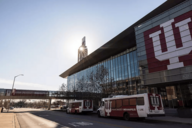You have /5 articles left.
Sign up for a free account or log in.
Well, not die, exactly. Transform.
“The term 'career services' has been a phrase that has been used for several decades to describe what colleges have been doing,” says Andy Chan, vice president for personal and career development at Wake Forest University. "It’s not working."
Chan co-edited the new report, "A Roadmap for Transforming the College-to-Career Experience."
“I’m being a little bit dramatic by saying it must die,” Chan says in an interview. “It’s just that that traditional model needs to be totally rethought and resurrected as something different.”
Traditional model: half-a-dozen -- or maybe a dozen, if it’s a big university -- overbooked counselors sit in an office and advise students who waited until their senior year to think about how they’re going to get a job. They work alone, independently, one office of many with a given student affairs niche to fill. They counsel and host job fairs and help students network -- but only for the students who show up to get help.
"It ends up just being treated as an office that’s one of dozens that performs a specific service,” Chan says, “when in the students’ mind it’s one of the most important questions they have when they come to the school.”
Roadmap for Transforming the College-to-Career Experience
1. Develop a Bold Vision and Mission for Personal Career Development
2. Secure Backing from Institutional Leadership
3. Strategically Position the Personal and Career Development Leadership Role
4. Strategically Transform, Build and Align Personal and Career Development Organization and Staff
5. Gather and Report Personal and Career Development Outcome Data to all Constituents
6. Engage and Equip a College-to-Career Community of Influencers with a Focus on Faculty and Parents
Transformed model: More staff than that – plus faculty members and administrators – work together to reach out to all students, from Day One. They work not just on career counseling but on employer and alumni relations, development, office operations and professional development. Their mission squares with the institution’s: they provide “personal and career development” to build lifetime employability. They are also a crucial unit of the college and are housed accordingly -- under a major administrator.
They gather and report personal and career development outcome data, which they publicize to all stakeholders to make a case supporting the value of higher education and the liberal arts. And they engage with faculty, parents, alumni and employers to build a network of “influencers” to provide help along the way.
“If you take the traditional idea of ‘career services’ and throw it out,” Chan says, “you can come up with a model where the institution is taking responsibility and being accountable for teaching students how to live meaningful, purposeful, successful lives.”
The model proposed in the report is based on a crowdsourced paper from attendees at last year’s “Rethinking Success” conference at Wake Forest, where they discussed the value of liberal arts education in the 21st century.
“What we’re pressed to do,” says Kelley Bishop, an assistant vice president of strategic initiatives at Michigan State University whose work is featured in the report, “is embed the career development process into the academic experience. That is the crux of our challenge for our profession for the next decade.”
A critical component of this approach is data-gathering. Many colleges, for whatever reason, just aren’t good at tracking and reporting graduates’ career outcomes. That lack of information leads people to decide that colleges – particularly liberal arts ones – aren’t making good on their promise to get graduates gainfully employed, even though that may not be true.
“To the extent that they’re paying attention to their students’ needs and the realities of the world of work today, I think many of them will say this is bold, but it’s the kind of thing that we need to be thinking about if we want to justify the value of higher education,” Chan says. “There are a lot of issues around trying to manage costs, which I completely understand, but the flip side of that question is, how do we continue to create and justify value that matters to our students?”
The report cites research from Michigan State's Collegiate Employment Research Institute. A survey of more than 800 employers found that the people hiring (or turning down) liberal arts students for jobs believe those recent graduates are equipped with the work place competencies they need, but were not able to articulate and demonstrate their abilities in job interviews, and did not learn several key technical and professional skills that are highly valued by employers. The report lays this problem at the feet of the universities.
“When we think about how dramatically the world of work has changed, it is remarkable that the methods utilized to prepare students to enter it have remained static,” the report reads. And though the methods may be static, the resources aren’t: colleges slashed career office budgets by an average of 16 percent this past year, the report says.
And there are costs – in time and money -- associated with this change.
At Michigan State, Bishop started forming a new “distributive approach” in 2001. Under that model, career services is still decentralized, in a way, as it is at most large universities. Typically, a university will have a very small office, perhaps just one person, at each school or college, but there is little if any coordination between them. At Michigan State, there are three main hubs whose staff are closely connected (or even reside) with those schools. They coordinate the college’s goals and agenda with the main center offices, embedding career development into the curriculum and helping to build students’ professional identity from the get-go.
Michigan State has overcome the traditional model’s challenge of getting students to use its services by taking the services to the students – and it increased demand so much that strains are emerging. At some point, the existing staff members won’t be able to personally handle 50,000 students. So they’re going to have to rethink how they allocate resources and work with third parties like faculty members. The “everything you need is here; come get it” approach is not going to fly anymore with new generations of students who expected everything to be taken care of for them, Bishop said.
“What we now set in motion, we need to reinvest,” he says. "We’re not going to pull back at this point…. This is where the scrutiny of higher education is coming -- what is the return on this investment?”
The report calls for bold change; change that could take decades. But Chan believes colleges are ready for it.
“I think given my conversations with many schools that this is something that many people would say, this should have happened a long time ago,” he says – and students and alumni might agree. “I think they’ll be pleased.”




